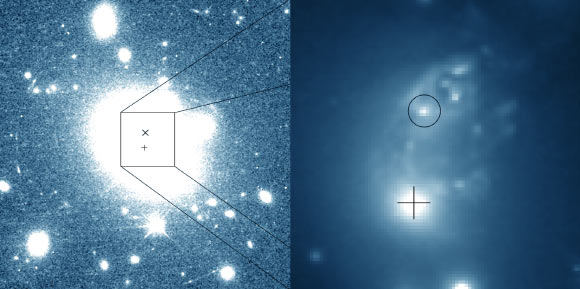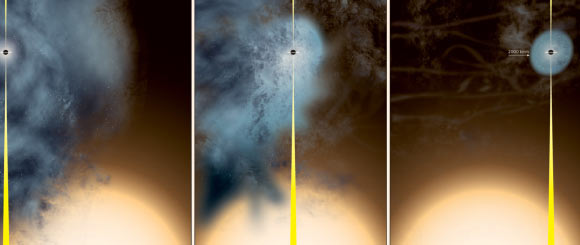A team of scientists led by National Radio Astronomy Observatory astronomer James Condon has found the shredded remains of a small galaxy that passed through a larger one, leaving only the smaller galaxy’s black hole to emerge and speed away at more than 2,000 miles per second.

Left: this deep Hubble image of the galaxy cluster ZwCl 1715.5+4229 (also known as ZwCl 8193) shows the full extent of the giant galaxy 2MASX 17171926+4226571 and some of its gravitationally lensed background galaxies. The white ‘X’ marks the VLBA radio position, the white ‘+’ marks the Hubble optical position of the giant galaxy’s core, and the white box bounds the zoomed image at right. Right: this shallower zoomed Hubble image of the galaxy cluster reveals the core of the giant galaxy, the smaller galaxy, several cluster galaxies, and extended interaction debris. The Hubble position of the giant galaxy’s core is marked by the white ‘+,’ and optical identification of B3 1715+425 is enclosed by a white circle centered on its Hubble position. Image credit: J.J. Condon et al / NASA / ESA / Hubble / NSF / VLBA.
“We were looking for orbiting pairs of supermassive black holes, with one offset from the center of a galaxy, as telltale evidence of a previous galaxy merger,” Dr. Condon said.
“Instead, we found this black hole fleeing from the larger galaxy and leaving a trail of debris behind it. We’ve not seen anything like this before.”
Dr. Condon and his colleagues from the University of Colorado, Max-Planck-Institute for Radio Astronomy and Astrogeo Center began their quest by using NSF’s Very Long Baseline Array (VLBA) to make images of more than 1,200 galaxies.
The VLBA observations showed that the supermassive black holes of nearly all these galaxies were at the centers of the galaxies.
However, one object, in ZwCl 1715.5+4229, a massive cluster of galaxies about 2 billion light-years away, did not fit that pattern.

Artist’s conception of how the ‘nearly naked’ supermassive black hole originated. Image credit: Bill Saxton, NRAO / AUI / NSF.
Further studies showed that this object, labeled B3 1715+425, is a supermassive black hole surrounded by a small galactic remnant only about 3,000 light-years across.
In addition, this object is speeding away from the core of a much larger galaxy, 2MASX 17171926+4226571, leaving a wake of ionized gas behind it.
The team concluded that B3 1715+425 is what has remained of a small galaxy that passed through the larger one and had most of its stars and gas stripped away by the encounter.
The speeding galactic remnant probably will lose more mass and cease forming new stars.
“In a billion years or so, it probably will be invisible. That means that there could be many more such objects left over from earlier galactic encounters that astronomers can’t detect,” Dr. Condon said.
The team’s findings have been accepted for publication in the Astrophysical Journal (arXiv.org preprint).
_____
J.J. Condon et al. 2016. A Nearly Naked Supermassive Black Hole. ApJ, accepted for publication; arXiv: 1606.04067







